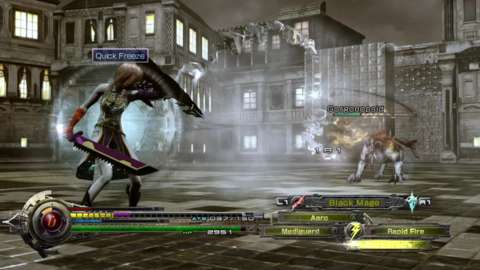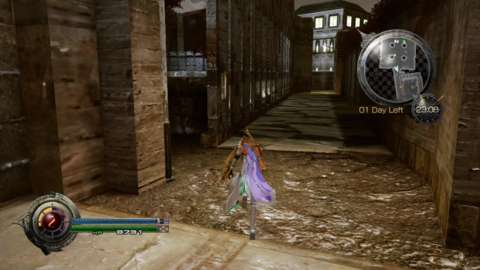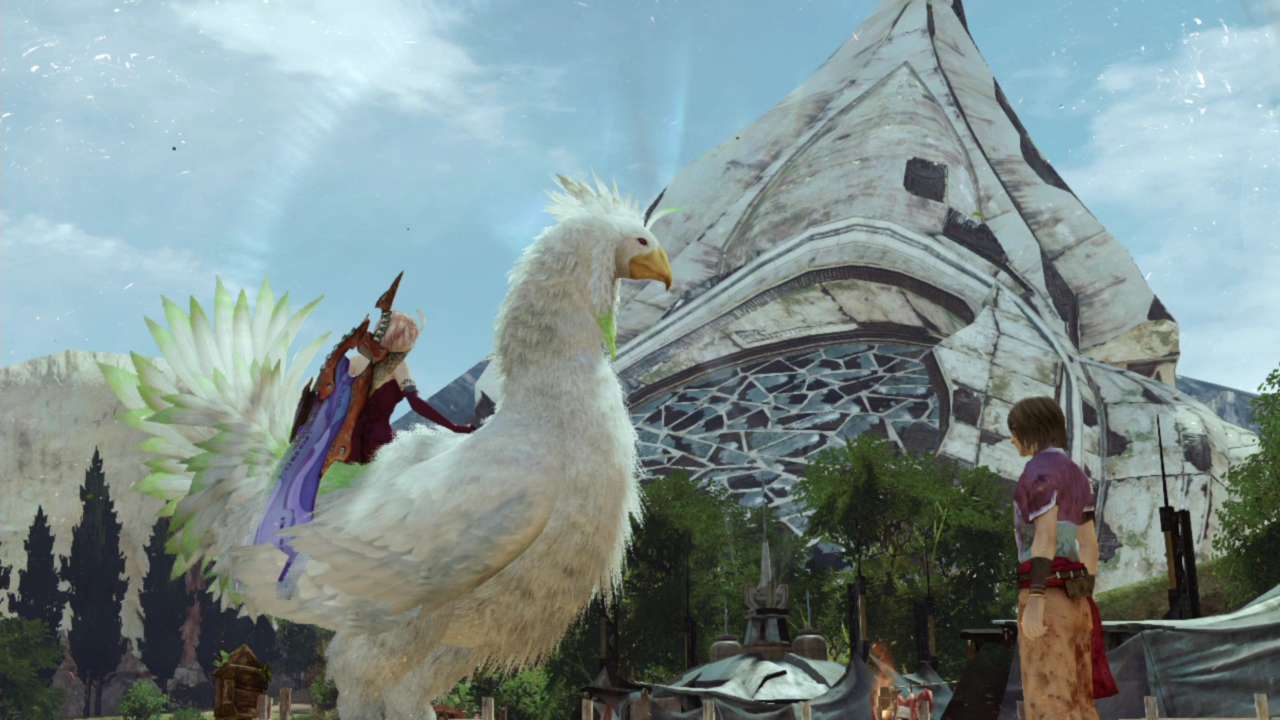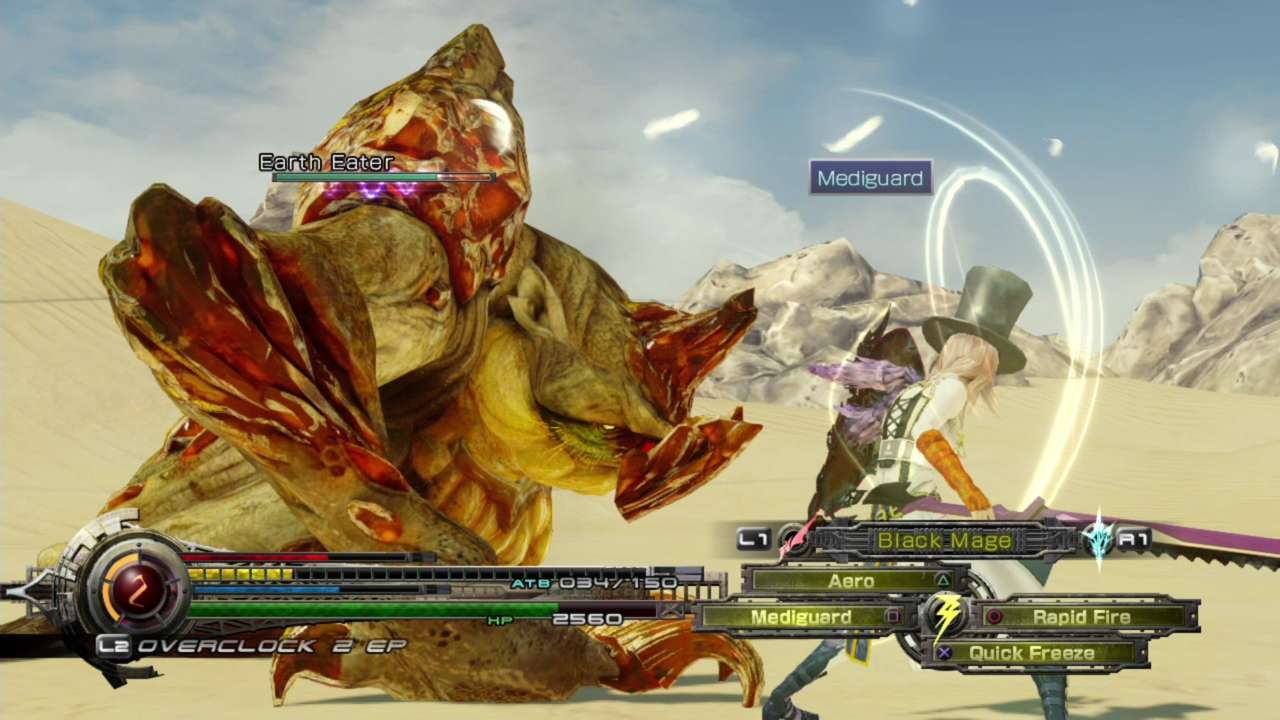"If I am a vessel, I am an empty one."
So says Lightning, aka Claire Farron, aka the heroine of Final Fantasy XIII, and now, the heroine of Lightning Returns. And she's right. In her newest adventure, Lightning is not interesting in and of herself, but because of what she means to others, and what others mean to her. To Bhunivelze--that is, God--she is the means of readying humanity for the new world soon to be born. To old friend Fang, she is the key to retrieving an artifact that holds untold power. As for Lightning, the only force driving her is her love for her dead-but-not-really sister Serah, and the possibility that they may be reunited--but even that possibility doesn't stir Lightning's emotions. Indeed, Lightning is a vessel for holding and pouring plot devices, but little more.
To be fair, Lightning's stoicism is a story point in Lightning Returns, yet it's this same stoicism that makes it nigh impossible to connect with her; she has but one personal motivation, and is defined solely by that motivation. In fact, every character in Lightning Returns is defined by the most basic of traits, all of which serve the needs of the plot, rather than the plot flowing from the needs of the characters. How amazing, then, that these characters never stop talking, finding new ways to explain the simple events occurring around them with as many words as possible. For having so little to say, the characters of Lightning Returns sure do talk a lot. You could say the same things about many other Japanese role-playing games, as well as plenty of anime and manga, but I can't remember the last time I played a game with so much dialogue that went absolutely nowhere.

The stage for all of these histrionics is the world of Nova Chrysalia--or, more accurately, four fairly large regions of Nova Chrysalia that you traverse over and over again as you perform the tasks required of you. The world is soon to end, and Lightning is the key to God's plan for a new beginning. She is the savior, the one who will rescue as many souls as possible in order to guide them to the new world, and Serah is God's bargaining chip. In turn, returning character Hope Estheim acts as Lightning's guide in his ark, a base that exists outside of time's flow, and houses Yggdrasil, the famed tree of life that has become a JRPG mainstay.
Lightning Returns is not a game about Lightning, but about events that unfold with such melodrama and visual panache that you can't help but gawk at the beautiful spectacle before you. Some of these events have some semblance of sense, while others (such as the arc that explains the ever-annoying Chocolina's backstory) are absurd fluff, but the "whoa" moments come and go with some degree of reliability, making you wish that they were part of a sophisticated narrative in addition to being sensory delights. In my favorite of the game's many cutscenes, Lightning dons a gorgeous mauve gown and takes center stage in a theatrical production that make a Cirque du Soleil show look like a flea circus. The music swoons, fireworks and other vibrant flourishes fill the screen, and for a moment, the pageantry sweeps you away in an exuberant gust of sound and light.
Lightning is a vessel for holding and pouring plot devices, but little more.

If only there were a stronger character who could readily support the weight of a full game on her shoulders. Lightning's friends from Final Fantasy XIII and Final Fantasy XIII-2 have roles to play, but their stories are typically self-contained, culminating in final speeches that might represent 180-degree turns of the emotional positions they held just moments before. At least some of the actors deliver their lines with enough gusto to make you believe in their proclaimed passions. Final Fantasy XIII-2's misunderstood villain Caius Ballad has the most stage presence among them, thanks to actor Liam O'Brien's resonant baritone, though even Vanille finds redemption now that she no longer must bear the burden of an entire world (rather literally, at that). Elsewhere, Lightning Returns embraces the usual monosyllabic coos and shrill vocal deliveries that characterize Final Fantasy, though this isn't a matter of acting choices, but rather of inconsistent voice direction.
Sadly, the mediocre audio production is a major distraction. You explore and reexplore the game's four zones as Lightning, who usually travels alone, with Hope chattering in your ear via transponder so frequently, you wish he'd just shut up. He drones on so often, in fact, that he's constantly cut off mid-sentence whenever a battle suddenly occurs, when you trigger a cutscene by walking into a new area, or when you engage another character in order to complete quests. In the most extreme examples, Hope cuts off his own dialogue, though even when he isn't the one providing his own interruptions, lines are constantly shut down mid-sentence, sometimes to be repeated, and sometimes to be forgotten. The game drowns you with unnecessary audio, as if developer Square Enix were fearful that you'd forget what you were doing or why you were doing it.

You might think you could simply wait for dialogue to finish before venturing forward or engaging other characters, and in theory, you can. However, Lightning Returns is designed to make you hurry. You see, the world is going to end whether you like it or not, and the clock is always ticking. The game adheres to a strict timetable, automatically returning you to the ark at 6 a.m. every day. To see Lightning Returns to its finale, you need to add several more days to the calendar by saving the right souls--which in turn means completing story quests. Stopping to listen to entire lines of dialogue uses up precious minutes, so when faced with the decision to do nothing while you listen to Hope ramble or to move on and risk interrupting his exposition, you move on. The countdown is anti-story.
The music swoons, fireworks and other vibrant flourishes fill the screen, and for a moment, the pageantry sweeps you away in an exuberant gust of sound and light.
Not only does the time management mechanic collide with the overzealous audio, but it collides with almost every other aspect of the game. I suspect that like me, many people will discover just how frustrating the flow of time is when they reach the world's end before they have progressed far enough to have saved its populace. In this circumstance, the game abruptly concludes, and then invites you to start over again with all of your spells, weapons, and so forth intact--a New Game Plus. The moment came as a slap in the face after 33 hours of playing on medium difficulty, and the slaps continued as I played through a second time, during which I could so clearly see all of Lightning Returns' attempts to pad the gameplay and waste my time. You can mitigate the frustrations by playing on easy, but doing so bandages the wounds without addressing the disease.
How does Lightning Returns waste your time? It does it in how it handles exploration. As you complete certain side quests, others may open up, but you may not know where and when they do so, or even if they will. In that sense, the game invites you to return to regions again and again, seeking out new activities. But the clock is always working against you, and the time you spend exploring previously visited areas may not yield any fruit, making the entire journey a pointless one; even traveling to other regions by train uses up additional time. In that sense, the game punishes exploration by pushing you ever closer to imminent Armageddon. The countdown is anti-exploration.

How else does Lightning Returns waste your time? It does it by forcing you to lose an in-game hour whenever you escape from battle, but not effectively communicating if you have the right tools for major enemies beforehand. You might be well equipped for the creatures in the vicinity, only to discover that you are not powerful enough for the boss that concludes your quest, or the miniboss that stands between you and the next phase of your journey. The combat system itself encourages you to try different approaches, but the clock punishes you for doing so. The countdown is anti-experimentation.
That combat has plenty of bright spots, however, and were it not for some execution issues, it may have even found a place among Final Fantasy's better battle systems. The paradigm mechanics of the previous games have been reimagined, and Lightning is the only character you directly control. At the heart of battle--and indeed, at the heart of character progression and customization--are combat templates called schemata. Schemata, in turn, are attached to the outfits Lightning wears. She can wear up to three at any time and switch between them at will during battle. Not only do various outfits have their own attributes, but so do the weapons, attacks, and accessories you can equip to them. As you earn new spoils in battle, visit vendors, and complete quests, your options grow, and schemata customization becomes more and more compelling. I enjoyed fine-tuning each schema, giving them descriptive names and maximizing various qualities with ornate shields and impossibly large katanas.
On the battlefield, additional strategic elements come into better focus. For instance, each schema has its own maximum health, but when you take damage in one schema, that damage is reflected in other schemata by the percentage of health you lost, rather than in the actual amount of damage. As a result, it's best to have the schema with the most health points equipped when the enemy lands its blows. In addition, certain costumes have a particular attack hardcoded into them; in other cases, equipping a given item or casting a particular debuff may change the nature of certain attacks. The inherent freedom of schemata makes them deeply appealing.
The game punishes exploration by pushing you ever closer to imminent Armageddon.

Once combat begins, however, you must face Lightning Returns' vexing blocking mechanic. Each attack you unleash costs a certain number of ATB (active time battle) points, and the ATB meter replenishes more slowly than you use it up. As a result, you must switch between schemata frequently--a strategic consideration similar to the one paradigms introduced in the other XIII games. It's the newfound emphasis on staggering that leads to the greatest aggravation on the battlefield. Staggering an enemy typically (but not always) makes it temporarily impotent in battle, and allows you to deliver a lot of damage without opposition. You can stagger enemies by bombarding them with the spells and slashes they are particularly vulnerable to, but precisely blocking their attacks is even more effective. And if you want to avoid grave injuries, it's sometimes a requirement.
The most obvious problem with blocking is that Lightning Returns, like its predecessors, values visual pageantry over precision. That was fine in the previous XIII games, which required little exactness, but when the camera is swaying about, framing the fluid animations, brilliant explosions, and fearsome monsters, it's rarely giving you a consistent view of your surroundings. You can click a thumbstick to watch from a better vantage point, but even then, the game's insistence on forcing beauty on you comes at the expense of granting you a proper perspective. Avoiding damage can require split-second timing, but you can't block attacks you can't see. And remember: while you can escape battle, it costs you time, though Lightning Returns does give you some methods to ward off the pain of lost hours, such as the limited skill to slow time to a crawl for a short while and prove yourself a one-woman army.

Nevertheless, the foes you face while pursuing story quests prove a roadblock the first time through, forcing you to pursue other opportunities and hope that making various citizens' dreams come true will help extend the clock. You might suppose that grinding for levels would boost your battle effectiveness, but Lightning doesn't gain levels, and there is no experience to gather. Instead, completing quests, whether they be story quests, side quests, or tasks offered from Chocolina's minor mission board, rewards you with additional health, additional strength, or other perks, such as an increase in the number of recovery items you can possess. Pursuing Chocolina's tasks is much the same as level grinding, only instead of fighting to earn experience, you are fighting to reap objects that you can turn in for a small boost to your attributes.
Most missions are of the usual "fetch" or "kill" variety, and have you crisscrossing the desert, weaving through forests, and roaming city streets. Menial tasks like checking the time on a dozen clocks or growing greens to feed to your chocobo mount aren't absorbing on their own, but they do get you out into the world, where you can complete assignments in any order you choose. And while treading across the same sand dunes and winding paths grows tiring, there are countless details to admire. When I first encountered a trio of miniature moogles roving the woods, chirpily greeting each other and announcing it was their bedtime, I was utterly delighted. I shuddered when I looked closely at a beastly gorgonopsid's razor-sharp teeth, before vanquishing it with a shimmering bolt of frost. And Lightning herself dons meticulously tailored outfits, with every button polished to a shine, each pair of boots carefully constructed, and each fabric impeccably embroidered.

Those details carry over into garb like the amazon warrior outfit, which covers only the minimum amount of skin, and features a panty line so low that Lightning looks like an extra from a hypersexual Onechanbara game. These outfits speak to the game's tonal inconsistencies; Lightning's costumes have always been body-conscious, but they've never been overtly provocative, and the sudden spotlight on Lightning's ladybits run contrary to her aloofness and professed desire to avoid the limelight. If you'd rather giggle than ogle, you can always equip Lightning with an adornment, like a bushy goatee or a feline tail, and then change her clothing colors to a garish puce-and-pea-green combo. Lightning doesn't smile, so you can't laugh with her--but at least you can laugh at her.
Games have successfully used timers to evoke a sense of urgency in the past; The Legend of Zelda: Majora's Mask leaps immediately to mind. Yet Majora's Mask handled its time limits with care, whereas Lightning Returns layers them on top of mechanics that don't support them. This supposedly final chapter of Nova Chrysalia's story leaves me befuddled. It's a collection of ideas and concepts that don't come together in a coherent way, led by a character who has shown no identifiable growth since her first appearance four years ago. The promising schemata system and grandiose cutscenes are solid pillars from which a great RPG could have been constructed, but Lightning Returns: Final Fantasy XIII falls well short of greatness.